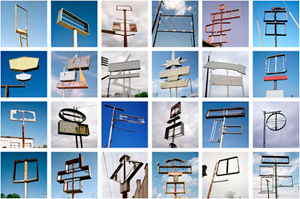Jeff Brouws
Images
| Biography
June 2nd –July 14th, 2012
Reception: June 2nd, 2012 4-6PM
Jeff Brouws will introduce his exhibition at 3:45pm on June 2, prior to the reception.
Over the past two decades, Jeff Brouws has pursued myriad bodies of work that explore the less savory, and perhaps more complex, manifestations of America’s cultural landscapes. His sixth solo show at Craig Krull Gallery, opening June 2, 2012, will feature work from three on-going series. As a self-described “visual anthropologist”, Brouws recognizes that photographs exist within a socio-economic, political, or historical context. Every landscape can be read as a “field of information” revealing evidence of the external forces that have shaped them. Grounded in a subtle formalism, Brouws’ photographs also ask the viewer to consider the systems that have facilitated their subject’s construction, or alternatively, their abandonment.
Brouws’ After Trinity project explores the historical remnants, and contemporary realities, of nuclear weapons and reflects his interest in identifying cultural evidence with broad sociological implications. Deeply affected after reading John Hersey’s Hiroshima as a student, he embarked on a wide-ranging photographic project in 1987 cataloging the symbols and artifacts of the atomic era. He made visits to document the Trinity site (location of the first atom bomb detonation), Los Alamos’ Bradbury Museum of Science dedicated to nuclear weapons, and the Nevada Test Site. Updating this project in 2009 with his Proximity series (a body of work for which he has received the 2012 Prix Pictet nomination) Brouws photographed active, nuclear-tipped ICBM Minuteman Missile silos and their adjacency to everyday places in rural North Dakota.
In two other bodies of work, from his Franchised and Discarded Landscapes series, Brouws references and complements the photography of the New Topographics movement of the 1970s. In addition to studying the newly constructed suburban world, as those artists so eloquently did, Brouws explores terrain vague inner city areas and considers how racial segregation, white flight, disinvestment, corporate takeovers, outsourcing, and other factors have reciprocally shaped urban, suburban and even highway spaces. As he clearly demonstrates, The New West has become a “non-place” landscape comprised of big box stores and fast food chains with their glowing, corporate logos mounted atop skyscraper-high poles. The poet Gary Snyder referred to these signs as “…skinny wildweed flowers sticking up…in the asphalt riparian zone.” Brouws creates single images and diptychs, as well as typologies such as his Signs Without Signification—portraits of light-box signs from once thriving, but now abandoned businesses that reveal Capitalism’s cyclical nature and it tendencies toward “creative destruction.”
Jeff Brouws has produced four monographs, including the 1992 homage to Ed Ruscha entitled Twentysix Abandoned Gasoline Stations. His most recent book is Approaching Nowhere published by W.W. Norton in 2006. His work can be found in the numerous museum collections including: The Whitney Museum of American Art, San Francisco Museum of Modern Art, Harvard's Fogg Museum, the Princeton University Art Museum, the Santa Barbara Museum of Art, and the J. Paul Getty Museum.
Brouws’ After Trinity project explores the historical remnants, and contemporary realities, of nuclear weapons and reflects his interest in identifying cultural evidence with broad sociological implications. Deeply affected after reading John Hersey’s Hiroshima as a student, he embarked on a wide-ranging photographic project in 1987 cataloging the symbols and artifacts of the atomic era. He made visits to document the Trinity site (location of the first atom bomb detonation), Los Alamos’ Bradbury Museum of Science dedicated to nuclear weapons, and the Nevada Test Site. Updating this project in 2009 with his Proximity series (a body of work for which he has received the 2012 Prix Pictet nomination) Brouws photographed active, nuclear-tipped ICBM Minuteman Missile silos and their adjacency to everyday places in rural North Dakota.
In two other bodies of work, from his Franchised and Discarded Landscapes series, Brouws references and complements the photography of the New Topographics movement of the 1970s. In addition to studying the newly constructed suburban world, as those artists so eloquently did, Brouws explores terrain vague inner city areas and considers how racial segregation, white flight, disinvestment, corporate takeovers, outsourcing, and other factors have reciprocally shaped urban, suburban and even highway spaces. As he clearly demonstrates, The New West has become a “non-place” landscape comprised of big box stores and fast food chains with their glowing, corporate logos mounted atop skyscraper-high poles. The poet Gary Snyder referred to these signs as “…skinny wildweed flowers sticking up…in the asphalt riparian zone.” Brouws creates single images and diptychs, as well as typologies such as his Signs Without Signification—portraits of light-box signs from once thriving, but now abandoned businesses that reveal Capitalism’s cyclical nature and it tendencies toward “creative destruction.”
Jeff Brouws has produced four monographs, including the 1992 homage to Ed Ruscha entitled Twentysix Abandoned Gasoline Stations. His most recent book is Approaching Nowhere published by W.W. Norton in 2006. His work can be found in the numerous museum collections including: The Whitney Museum of American Art, San Francisco Museum of Modern Art, Harvard's Fogg Museum, the Princeton University Art Museum, the Santa Barbara Museum of Art, and the J. Paul Getty Museum.

